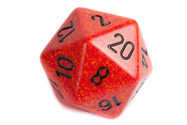Dungeons and doctors
A new way to teach students borrows heavily from a popular game.
Educators are constantly searching for new ways to instruct. Whether we're dealing with medical students or residents, part of the core of our profession is teaching.
Rather than leaving this to the recognized experts, we decided to get a cut of the action and come up with our own pedagogical schtick. What better way to nab a prestigious publication in a medical education journal, advance our academic careers, and present in some exotic far-off land, like Poughkeepsie? And possibly edify and enlighten along the way?

The problem was, all of the best ideas were taken—poetry workshops, theater, improv comedy, video games, and so on. So we brainstormed, desperate for something, anything, with the sheer novelty to land us in the scholarly limelight.
Our brains were beyond storming; they were cerebral cyclones. Tempests of cutting-edge concepts swirled around: horticulture, quilting, interpretive dance. We favored skeet shooting or bird watching—perhaps combining the two?
But our experiments with these pedagogical tools led nowhere. In one unfortunate test-of-concept, a rare sighting of a wayward ivory-billed woodpecker was abruptly cut short by a misfired clay-pigeon launch. So as not to waste the IRB-approved effort, we conclusively resolved the age-old question of whether an endangered bird could survive a ballistic collision with a four-inch diameter clay disk. Look out for our upcoming publication in Nature!
We were still left without an idea, a clue, or a publication in a medical education journal. Then, in a flash of insight, one of our minions suggested we look into role-playing games. Thus, we set to work producing our very first edition of “Dungeons and Doctors.”
Character and class creation within the game was easy to grasp, particularly since the learners had ample experience with online identities from dating websites. Would the player want to be an Elvish family medicine resident with special abilities in public health? How about a troll from the emergency department with a magic, undefendable admission key? A half-Orc orthopod, a Golem gynecologist, an Ent otolaryngologist? The possibilities were endless. Our character creation manual quickly racked up several hundred pages to accommodate the wide range of choices.
It wasn't always easy to translate the world of tabletop roleplaying to a medical context, however. It might seem intuitive to apply combat encounters—so central to role-playing games—to patient care. But a quick test revealed that a young hospitalist wielding a +3 quarterstaff doesn't do much for an osteoporotic patient's compression fracture.
The various quests we provided for our “dungeon masters” were a highlight of the gaming experience, at least for us. Are you a Halfling intern with a bonus in “bluffing” tactics? Then a special quest in surviving malicious pimpage by the half-rodent residency director is just the thing to help you “level up.” What if you are a troglodyte medical student with a boost to your speed? In that case, your resident has a quest for you: Run down to the cafeteria and get those coffees before morning rounds! Add on an extra 100 experience points if you also grab donuts and croissants.
Of course, every dungeon master knows that players love a good “campaign”—that is, playing successively harder encounters before the final showdown with a “boss.” This was relatively easy to work into our first edition of Dungeons and Doctors. After choosing a service, players worked their way through a variety of quests—staying awake during grand rounds, battling a rampaging epidemic of C. diff, and writing the discharge summary on a patient with a 172-day length of stay.
But the granddaddy of the campaign was one that every hospital medicine fellow knew: the busy night on call. Learners were particularly challenged by the concept of staying up all night while remaining vigilant. On the first admission, roll the specially developed “doctor dice” and see what you get. The red die gives you your diagnosis—the higher the number, the higher the acuity. Roll a 2 and you'll get alcohol withdrawal; a 16 and it's calciphylaxis.
Then, roll the blue “family-social” die. A dedicated drug abuser? An intense spouse? Finally, the green insurance die, the white comorbidity die, and the pink medication die, with a polypharmacy modifier. In some cases, your last roll will be the black die, for hospital complications, morbidity and mortality. Here, no roll is good.
Despite the amount of time required to master Dungeons and Doctors (about the same amount of time as studying for boards or learning Portuguese), the game was a resounding success. What better way to teach medical professionalism than by swinging your trusty +2 stethoscope at an enchanted Austin-Flint murmur? In fact, we're already working on several expansions—”Dungeons and Doctors: Private Practice,” “Dungeons and Doctors: Complementary and Alternative Medicine,” and our hotly anticipated “Dungeons and Doctors: Health Care Reform.”



